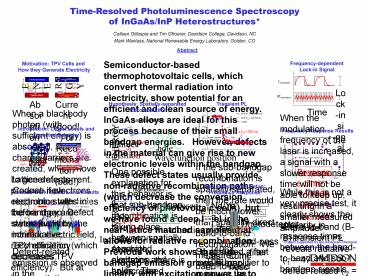TimeResolved Photoluminescence Spectroscopy of InGaAsInP Heterostructures - PowerPoint PPT Presentation
1 / 1
Title:
TimeResolved Photoluminescence Spectroscopy of InGaAsInP Heterostructures
Description:
Time-Resolved Photoluminescence Spectroscopy of InGaAs/InP ... amplifier is more sensitive than the boxcar averager that we used to measure transient PL. ... – PowerPoint PPT presentation
Number of Views:391
Avg rating:3.0/5.0
Title: TimeResolved Photoluminescence Spectroscopy of InGaAsInP Heterostructures
1
Time-Resolved Photoluminescence Spectroscopy of
InGaAs/InP Heterostructures Colleen Gillespie
and Tim Gfroerer, Davidson College, Davidson,
NC Mark Wanlass, National Renewable Energy
Laboratory, Golden, CO
Abstract Semiconductor-based thermophotovoltaic
cells, which convert thermal radiation into
electricity, show potential for an efficient and
clean source of energy. InGaAs alloys are ideal
for this process because of their small bandgap
energies. However, defects in the material can
give rise to new electronic levels within the
bandgap. These defect states usually provide
non-radiative recombination paths (which decrease
the conversion efficiency of photovoltaic cells),
but we have found a deep level in the
near-lattice matched samples that allows for
radiative recombination. Previous work shows
that sub-bandgap emission grows super-linearly
with excitation power up to and exceeding 1000
W/cm2. This unusual result suggests that the
defect-related radiative process is complex. We
hypothesized that the electrons and holes are
physically separated at the defect sites, so that
increasing excitation leads to an increase in
electron-hole wavefunction overlap and an
increased recombination rate. If the electrons
and holes are spatially separated, the resulting
transition times should generally be much longer
than those of the band-to-band transitions. We
have measured the sub-bandgap and band-to-band
recombination rates and find that our
experimental results are inconsistent with the
spatial separation model.
Hypothesis Spatially-separated Recombination
- Conclusions
- Band-to-band (B-B) transient PL reveals radiative
(t1 47ns) and defect-related (t2 920ns)
mechanisms as expected. - Sub-band gap (SBG) and B-B response times are
similar (approximately 1 microsec). - Results are inconsistent with spatial separation
hypothesis. - The similiarity in SBG and B-B response indicates
that the mechanisms are more closely related than
expected.
Project supported by the American Chemical
Society Petroleum Research Fund

